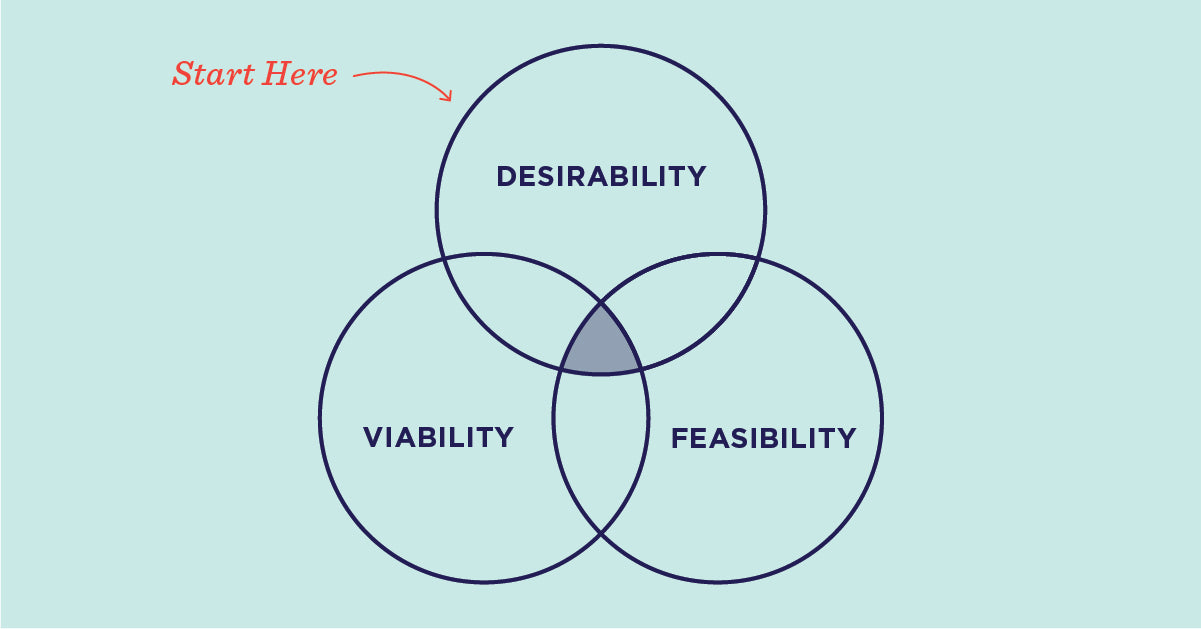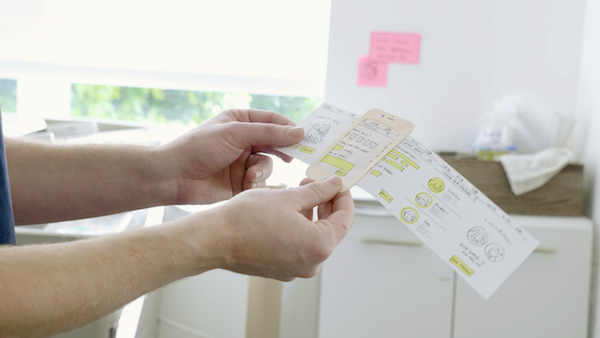What is Design Thinking?
Design thinking is a process for creative problem solving.
Design thinking has a human-centered core. It encourages organizations to focus on the people they're creating for, which leads to better products, services, and internal processes. When you sit down to create a solution for a business need, the first question should always be what's the human need behind it?
In employing design thinking, you’re pulling together what’s desirable from a human point of view with what is technologically feasible and economically viable. It also allows those who aren't trained as designers to use creative tools to address a vast range of challenges. The process starts with taking action and understanding the right questions. It’s about embracing simple mindset shifts and tackling problems from a new direction.

Design thinking can help your team or organization:
- Better understand the unmet needs of the people you’re creating for (customers, clients, students, users, etc...).
- Reduce the risk associated with launching new ideas, products, and services.
- Generate solutions that are revolutionary, not just incremental.
- Learn and iterate faster.
Design Thinking Applications:
Design thinking is applicable no matter your role or industry. Whether you work in business, government, education, or nonprofit, design thinking can help you develop innovative solutions based on the needs of your customers. See case studies showcasing the impact of design thinking across a variety of industries and practices.
Phases of Design Thinking
We teach the phases of design thinking as linear steps, but in practice the process is not always linear. Some of these steps may happen several times, and you may even jump back and forth between them. Moving through the phases of design thinking can take you from a blank slate to a new, innovative solution.
- Frame a Question—Identify a driving question that inspires others to search for creative solutions.
- Gather Inspiration—Inspire new thinking by discovering what people really need.
- Generate Ideas—Push past obvious solutions to get to breakthrough ideas.
- Make Ideas Tangible—Build rough prototypes to learn how to make ideas better.
- Test to Learn—Refine ideas by gathering feedback and experimenting forward.
- Share the Story—Craft a human story to inspire others toward action.
When done right, design thinking will help you understand the mindsets and needs of the people you're creating for, surface opportunities based on these needs, and lead you to innovative new solutions starting with quick, low-fidelity experiments that provide learning and gradually increase in fidelity.
4 Ways to Get Started with Design Thinking
1. Gather Insights by Practicing Empathy, Observation, and Interviewing
Getting to know your customers is the first step toward creating products and services they want and need. Don’t assume you know what someone thinks or feels. Gathering information about your target consumer is a critical piece of the design thinking approach. Build your interview skills with these tips.
2. Build Scrappy Prototypes to Learn About Unmet Needs
You don’t need lots of time or resources to prototype. Begin with pen and paper or other accessible resources, like a slide deck, to mock up ideas and get feedback that will help you better understand the needs of your customers before investing in production.
At IDEO, we worked with a large media firm undergoing a big reorganization. The team prototyped possible changes to the organizational structure by using constraints to create 6-week experimental teams. The goal was not for the teams to succeed necessarily, but for the company to gain some learnings that could inform a better structure.

3. Turn Problems into Questions
When presented with a problem, resist the urge to find a solution right away. Shift your mindset to instead ask a question that might get you closer to the root of the challenge or support an incremental improvement.
Take the example of an IDEO team who was working with a company struggling with retention. Instead of focusing on improving retention rates, they asked, How can we make a better employee experience? By refocusing on the real human needs, they uncovered insights that were better able to drive toward a solution.
4. Use Research to Understand the Past, Present, and Future
IDEO typically uses lots of different research techniques to generate insights around the needs of people including, but not limited to, observation, interviewing, immersive empathy, and exploring extreme users.
Generally, the type of research you can do falls into three buckets, generative research, evaluative research, and validating research. Generative research helps identify new opportunities and explores needs. Evaluative research gathers feedback on experiments and helps you iterate forward. These two types of research are focused on the future and new ideas, while traditional market research, known as validating research is intended to understand what is currently happening. Balance your research approach to focus on what’s happening now and what could be in the future.
Creative Confidence Series Webcast Episode
In an episode of our Creative Confidence Series, Sina Mossayeb, a systems designer at IDEO, talked with Coe Leta Stafford, IDEO U co-managing director, about the design thinking process. Watch the full episode for their tips on how to apply design thinking methodology at your business and actionable tips and activities to get started.
Webcast Chapters
(1:10) About Sina Mossayeb: As a systems designer at IDEO, Sina designs social movements.
(2:13) About Coe Leta Stafford: IDEO Design Director and Managing Director at IDEO U.
(3:12) Course Overview: Observing, Interviewing, Immersive empathy, Sharing insights, and Learning from extremes.
(4:22) What is Design Thinking: A process for creative problem-solving that includes empathy/human-centeredness, ideation, and experimentation.
(7:25) Change in Organizations: Look at the human needs first.
(8:57) Getting Actionable: Create versions of your ideas that people can participate in.
(10:54) Design Thinking Exercises: What’s in your bag? As a way of observing what people value.
(14:00) Scrappy Prototypes: Build just enough to create momentum.
(15:14) Skills + Frameworks: 3 main frameworks: 2x2, Venn diagram, and the journey map
(19:00) Design Movements: Tools for simplifying the message
(20:40) Business KPIs: Reframe the business need as a human need.
(26:00) Increase Employee Retention: How might we improve employee experience?
(27:22) Shift Culture through Design Thinking: Design thinking mindsets + processes can apply to systems and large scale problems.
(29:15) A Culture of Innovation: Embraces ambiguity, experimentation, and learning. Meet your company where they are.
(33:32) Design Thinking in Change-averse Companies: Find the right collaborators and experiment on your small teams.
(35:17) Apply Design Thinking to Services: Create constraints around experiments. Unify around the problem.
(39:30) Pair Market Research + Generative Research: Identify new opportunities, explore needs, and understand what is currently happening in the market.
(44:10) Can Any Problem Be Solved By Design: Are there limits to design? Are there limits to problems?
(46:41) The Gift of the Question: When faced with a problem, what question you can ask to better understand the situation.
To take your learning further, gain a practical understanding of the essential design thinking skills and mindsets with IDEO U’s Foundations in Design Thinking Certificate.
- choosing a selection results in a full page refresh
- press the space key then arrow keys to make a selection



